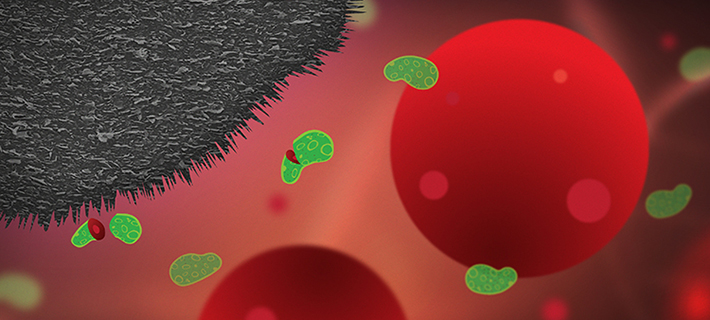Mar 24 2020
According to a study performed by Sweden-based Chalmers University of Technology and published in the Small journal, graphite nanoplatelets embedded in plastic medical surfaces can prevent infections and kill 99.99% bacteria that attempt to latch.

The nanoplatelets on the surface of the implants prevent bacterial infection but, crucially, without damaging healthy human cells. Image Credit: Yen Strandqvist/Chalmers.
This method offers a low-cost and feasible potential solution to an issue that impacts millions of people, speeds up antibiotic resistance, and costs large amounts of both time and money.
According to the European Centre for Disease Prevention and Control (ECDC), every year, more than four million individuals in Europe are impacted by infections that are contracted at the time of health-care protocols.
Most of these infections are caused by bacteria that develop around medical instruments as well as implants inside the body, like catheters, dental implants, or hip and knee prostheses. In the worst scenarios, implants had to be removed.
Such bacterial infections not only cause extreme suffering for patients but also cost a considerable amount of time and money to healthcare services. Moreover, vast amounts of antibiotics are presently used for treating and preventing such infections, but such drugs cost more money and speed up the development of antibiotic resistance.
The purpose of our research is to develop antibacterial surfaces which can reduce the number of infections and subsequent need for antibiotics, and to which bacteria cannot develop resistance. We have now shown that tailored surfaces formed of a mixture of polyethylene and graphite nanoplatelets can kill 99.99 per cent of bacteria which try to attach to the surface,
Santosh Pandit, Postdoctoral Researcher, Department of Biology and Biotechnology, Chalmers University of Technology
Pandit is part of the research team of Professor Ivan Mijakovic at the Division of Systems Biology of Chalmers University of Technology.
Outstanding Antibacterial Effects
Infections occur on implants when bacteria circulate in the body through the blood and other types of fluids, looking for a surface to adhere to. When these microorganisms land on an appropriate surface, they begin to multiply and create a biofilm called bacterial coating.
Earlier studies performed by scientists at the Chalmers University of Technology demonstrated how upright flakes of graphene, when positioned on an implant’s surface, could create a protective biofilm and thus make it impossible for the microorganisms to attach – similar to spikes on buildings developed to thwart birds from nesting.
The vertical flakes of graphene disrupt the cell membrane and destroy the microorganisms. However, it is expensive to create these graphene flakes and presently not practical for commercial production.
But now, we have achieved the same outstanding antibacterial effects, but using relatively inexpensive graphite nanoplatelets, mixed with a very versatile polymer.
Roland Kádár, Associate Professor, Department of Industrial and Materials Science, Chalmers University of Technology
Kádár continued, “The polymer, or plastic, is not inherently compatible with the graphite nanoplatelets, but with standard plastic manufacturing techniques, we succeeded in tailoring the microstructure of the material, with rather high filler loadings, to achieve the desired effect. And now it has great potential for a number of biomedical applications.”
No Damage to Human Cells
The graphite nanoplatelets embedded on the implants’ surface, inhibit bacterial infection but, most significantly, without affecting the healthy human cells. Human cells are approximately 25 times bigger than that of bacteria; hence, while the graphite nanoplatelets cut apart and destroy the pathogens, they are hardly able to damage a human cell.
“In addition to reducing patients’ suffering and the need for antibiotics, implants like these could lead to less requirement for subsequent work, since they could remain in the body for much longer than those used today,” added Santosh Pandit. “Our research could also contribute to reducing the enormous costs that such infections cause health care services worldwide.”
Correct Orientation is the Decisive Factor
In their analysis, the scientists tested varying concentrations of graphite nanoplatelets as well as the plastic material. A composition of about 15% to 20% graphite nanoplatelets exhibited the highest antibacterial effect—demonstrating that the morphology is extremely structured.
As in the previous study, the decisive factor is orienting and distributing the graphite nanoplatelets correctly. They have to be very precisely ordered to achieve maximum effect.
Roland Kádár, Associate Professor, Department of Industrial and Materials Science, Chalmers University of Technology
The research was a joint effort between the Division of Engineering Materials at the Department of Industrial and Materials Science at the Chalmers University of Technology, the Division of Systems and Synthetic Biology at the Department of Biology and Biological Engineering, and the medical company Wellspect Healthcare, who develops catheters, among a host of other products.
The novel antibacterial surfaces were created by Karolina Gaska while she was working as a postdoctoral researcher in the team of Associate Professor Roland Kádár.
The upcoming efforts of the scientists will now be focused on tapping the entire potential of the antibacterial surfaces for particular biomedical applications.